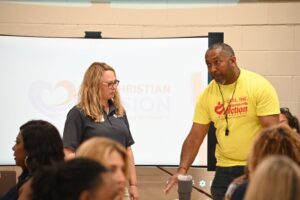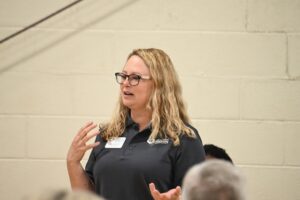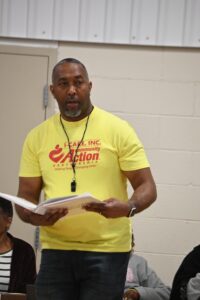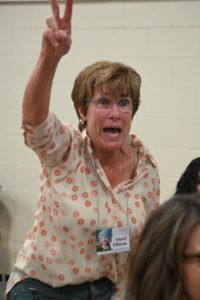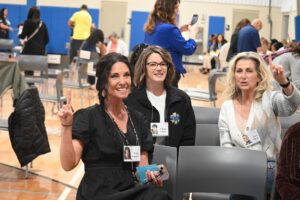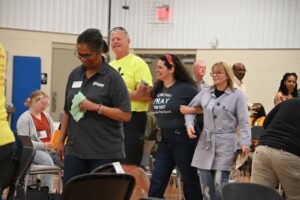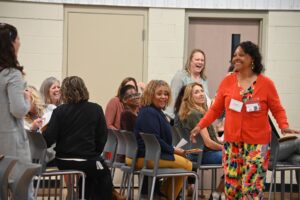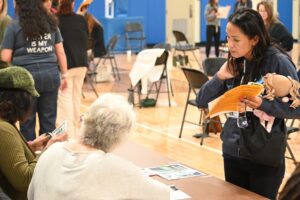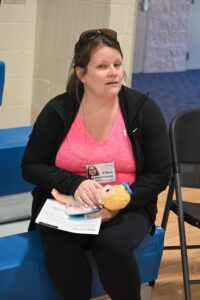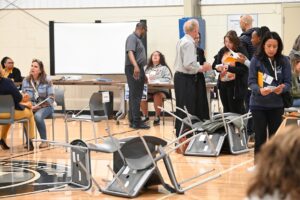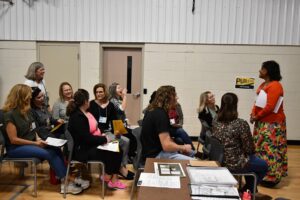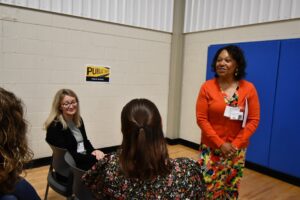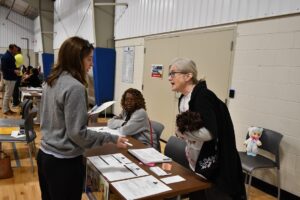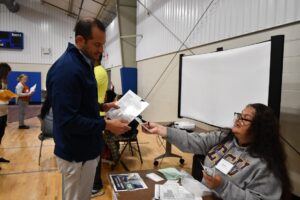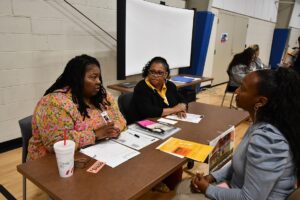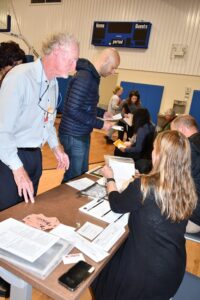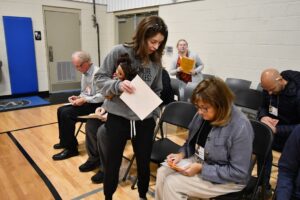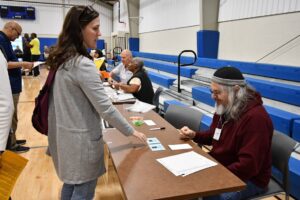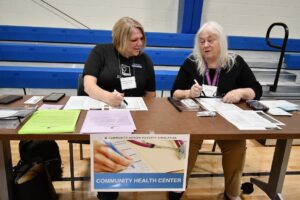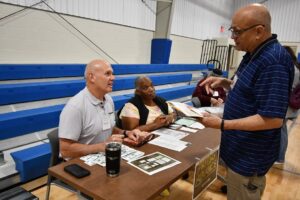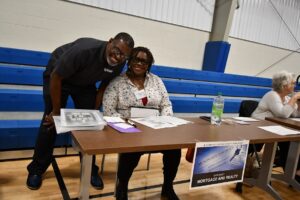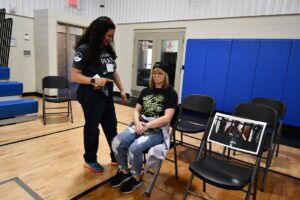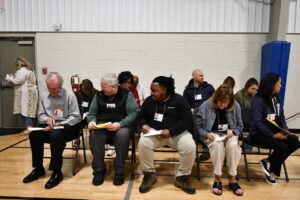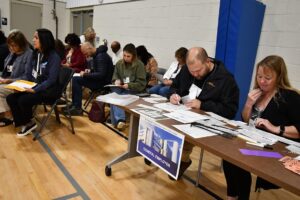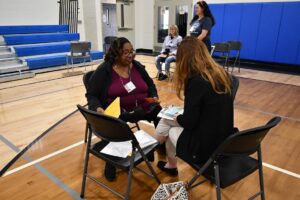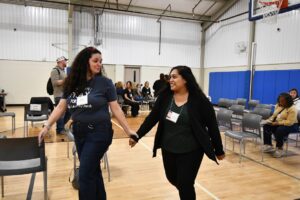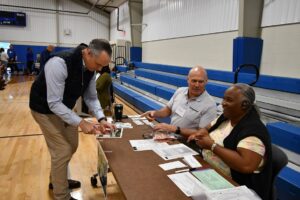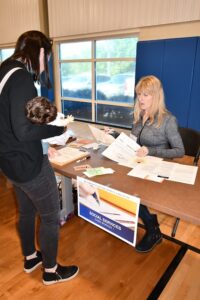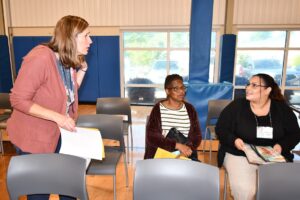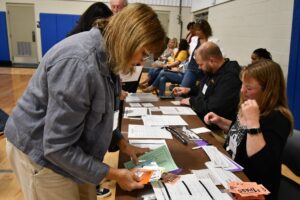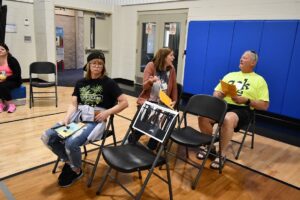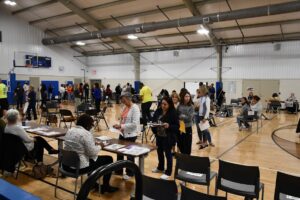
BY DEBBIE PAGE
About 100 people participated in The Christian Mission’s Poverty Simulation on Tuesday to experience a “month” of struggling to meet basic survival needs for themselves and their families. The organization’s mission is to break the cycle of poverty in the community.
Each participant took on the role of a person experiencing some degree of poverty, complete with a detailed history, specific life situation, sources of income, and family group.
I-CARE Executive Director Bryan Duncan, who served as emcee for the event, told participants that “the object of this experience is to sensitize us to the day-to-day realities of life faced by people with low income and to motivate us to become involved in activities which help reduce poverty in this country.”
The participants might want to see the simulation as a game, but Duncan warned them not to because “the statistics and situations we use are real, based on real life experiences of families with low income.”
“Poverty is not a game for the over 38 million United States citizens whose lifestyles you will simulate,” Duncan said. “You are going to try to walk a mile in the shoes of those who are poor.”
Duncan also asked participants be as realistic as possible about their role, acting the age and position that they have been assigned, noting that no healthy teenagers sit quietly at home, a child who has not eaten will cry and complain, the adults seeking work are often frustrated and irritable, and parents can get desperate in their search for food and shelter for their children.
“Try to think as a person facing poverty would think,” said Duncan.
He also warned them that surprises may occur.
“Sometime during the month, someone may be visiting your family with a “Luck of the Draw” card. These represent the unexpected hand of fate in all our lives, sometimes bringing good news, sometimes bad. You are expected to follow the instructions on these cards.”
Transportation is a difficult problem for many in poverty. Participants were required to have transportation passes, which represent the cost of public or private transportation, to go anywhere in the community because needed resources are seldom within walking distance of their homes.
Each community resource station in the room required a transportation pass before the representative would talk to the person about needed services. Resources included banking, crisis services, social services, medical care, mortgage company, childcare, homeless shelter, grocery store, employment, school, and other needs.
Those who were employed full-time needed five transportation passes to get to work and must be at the employer for seven minutes of the 20 of each round to represent the time spent at a job.
Employees were expected to be at work and ready to go within three minutes of the start of the week. Part-time employees only had to be at work for four minutes and required only three transportation passes.
Duncan reminded people to keep in mind that their goals during the month were to keep their homes secure, to feed their family regularly, to keep their utilities working, to make all necessary loan payments, and to pay for all miscellaneous expenses.
Those with school-age children must ensure that their children are in school, and if the children are preschoolers, they must ensure the children are cared for while at work.
SIMULATION EXPERIENCES
After giving participants time to study their packets, Duncan blew the whistle to begin the first 20-minute round. Participants scrambled to get to various resources around the perimeter of the room and obtain what they needed.
When the whistle blew at the end of the period, everyone had to stop and return to their home base, whether or not their transactions, job time, or appointment were completed.
Several participants were arrested for drug possession or stealing and taken to the jail. Others received cards which threw them expensive curves or gave them a positive situation that assisted their family. Some also got notices to visit DSS to keep their benefits.
In the third round, school was out so parents scrambled to find childcare as needed. After the third round, Duncan warned, “Some of you are not feeding your children.”
Several families became homeless after eviction, which was indicated by the family group’s chairs being turned upside down.
By the time the whistle blew to begin the fourth session, participants ran to the resource table, pushing and jostling others. Obviously, the pressure was increasing on them to help their family survive.
The school room area was quite challenging for Iredell-Statesville School’s Marlene Scott because of unruly and hungry students stressed by poverty. By the fourth session, Scott had arranged the chairs in a circle rather than a row to create more direct contact with students.
By the end of the fourth round, eight families were evicted with the homeless shelter running out of beds. However, a few were able to make payments and keep their homes. As he whistled the end of the fourth session, Duncan said, “Return to your homes — if you still have one.”
REACTIONS
After the simulation, Duncan invited participants to share their reactions and perceptions of the simulation experience.
One participant portraying a nine-year-old boy with asthma and intellectual delays emphasized the stress of the situation. “I could not imagine being a nine-year-old and living in this situation every day.”
Another had a comfortable home situation until one day the family came home to find an eviction notice, leaving them perplexed at what to do. The bank and mortgage company were unhelpful, and the fact that there was no prior notice really hurt. The participants said they never figured out how to solve their homelessness by the end of the simulation.
Duncan noted that evictions with little or no notice are not an uncommon circumstance for people living in poverty.
Another participant portrayed a father whose wife left, leaving him to care their children. He found it very stressful that he could not take care of his family and protect his children, no matter how hard he worked.
“It really hurt. I was tired and worn out by the end and did the best I could, but I couldn’t do it.”
Another participant was head of the family with a wife and children and a partially paralyzed mother-in-law who needed a lot of services. He pushed his unemployed wife to get a job to help meet all their financial needs. There was a lot of stress and strain on all the family while caring for three generations.
Duncan commented that situational poverty is becoming more common. People who worked hard all their lives are now having to care for both their children and their parents, a part of the so-called “sandwich” generation because elderly parents may not have enough income to pay their bills or need health care assistance.
Another participant noted that he wanted to help others in difficult situations, but he was one check away from the same poverty situation. He couldn’t help others in need because he had to take care of his own family.
“I’m grateful for this experience because it gives me a different lens to view people who are struggling in life,” he said.
Another participant portrayed a 14-year-old teenager and saw the family struggle on a daily basis because her mom and brother had no jobs and the brother had a pregnant girlfriend. To help the family out, she skipped school to babysit to get money for her family but ended up in juvenile detention. The mother who hired her lost her job for encouraging truancy. “It was an eye-opening experience,” she said.
Another participant was a 70-year-old veteran with medical issues. He could not pay his bills on his small pension and Social Security check. He sold his medication to make ends meet, not caring if he went to jail because at least then he would have three meals to eat and a place to sleep.
“We are so quick to judge others, not knowing what they have suffered. Having compassion and serving people who are struggling is so important,” he said.
Another participant was a father without a job and his employed wife was the only one with health insurance. His teen daughter was pregnant and her boyfriend was a felon who helped provide for her and their unborn child by stealing. The family had to decide what bills they would be able to pay each week. The father encouraged his daughter to miss school to help with the family’s needs until his wife insisted that the daughter go to school. They were often hungry because food cost $110 per month, but only about $50 was left after other bills were paid.
“The 16-year-old had to become an adult way too soon and rely on an illegal way to provide for her and her child. This is why kids are growing up way too fast,” he said.
Another participant who had her money, belongings, and ID card stolen was shocked to find that without an ID, she could not do anything. She struggled to get food and wondered how anyone homeless could maintain laundry and hygiene to possibly get a job.
One participant who works with people in poverty was shocked at how how quickly he became hopeless and felt overcome by his situation. “It was very stressful to try to figure out how to get out,” he said.
He added that community support and encouragement is essential to help people who feel powerless and that trying to move forward is pointless. He understood why some feel jail is better than their current circumstances, so they risk stealing and gaming the system. He felt like they weren’t bad people. “They just had no other options.”
People who ran the resource tables also noted that those without identification cards truly had their hands tied when trying to access assistance. The resources were also only open during work hours, making them nearly impossible to visit. Those resource tables were also struggling with how to help those who needed IDs.
The person running the church homeless shelter noted that helping agency partners need to be close and know each other services well, combining them to help others who are struggling to find the help they need.
A participant who has experienced homelessness noted that without a permanent address, a person cannot get an ID, which is a huge gap not being addressed. The person who ran the grocery store said that many did not eat on some weeks. The church charity was frustrated that they had such limited resources to help people, and the childcare only filled two of six slots, even the week that school was out.
The participants were trying to be resourceful to care for their children because they could not afford added childcare costs.
Christian Mission Director Amy LaCount noted that servic providers, agencies, and resources working together was very important to help lift people out of poverty. She is excited that in their new building on N. Main Street, which is expected to open early next year, they will also house the Iredell County Partnership for Young Children and NC Works, which will help clients meet multiple needs during one visit to the facility.
ABOUT THE CHRISTIAN MISSION
The Christian Mission helps clients break the cycle of poverty by engaging with families, giving them a support system, and helping them find the resources they need to successfully move ahead.
Scotty Moore, who has been with the agency for 17 years, said the mission first only gave out food and clothing and helped help with rent and utilities through crisis services, but soon they realized that was just a band-aid on a much larger problem.
The organization expanded its services to include poverty reduction education programs, case workers, and peer support for those with substance use disorder. The new facility will have space for additional case workers and program expansion.
LaCount said that they see people every day who are working very hard, and they want to offer more services to help improve their situations. Having classrooms and meeting spaces in the new facility will allow the agency to help community members grow in a much bigger way.
As they invest time and resources in folks who are struggling, LaCount expects see to real change come about in the community as The Christian Mission makes meaningful differences in people’s lives.
PHOTOS

